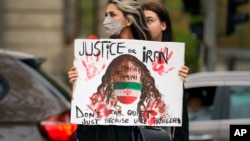It’s been two years since Mahsa Amini died in the custody of the so-called “morality police” in Tehran, after she was arrested for wearing her hijab improperly.
Her death kindled some of the largest anti-government demonstrations in Iran since the 1979 Islamic revolution. Led by women and girls, thousands of Iranians poured into streets across the country initiating what is known as the “Woman, Life, Freedom” movement. Authorities responded with a brutal crackdown: 500 people were killed and 20,000 arrested. In the months that followed, executions in Iran spiked.
The crackdown by Iranian authorities continues, and, as UN-appointed independent experts on Iran recently reported, has intensified. They wrote: “State authorities have expanded repressive measures and policies to further deprive women and girls of their fundamental rights. The Government has enhanced surveillance of hijab compliance in both the public and private spheres, while increasing previously established patterns of violence against women and girls who flout the mandatory hijab. In parallel, State authorities have increasingly invoked the use of the death penalty against women activists and scaled up executions against others who had expressed solidarity with the ‘Woman, Life, Freedom’ movement.”
In a joint statement, Secretary of State Antony Blinken and the Foreign Ministers of Australia, Canada, New Zealand, and the United Kingdom called on Iran’s new administration “to fulfill its pledge to ease pressure on civil society in Iran and to end the use of force to enforce the hijab requirement.” They also deplored the “shocking” recent surge in executions in Iran “that have largely occurred without fair trails,” and pledged to “use all relevant national legal authorities to promote accountability for Iranian human rights violators.”
On September 18, the U.S. Treasury Department announced sanctions against 12 individuals in connection with the Iranian regime’s ongoing repression of the Iranian people. Those designated include members of the Islamic Revolutionary Guard Corps and officials of Iran’s Prisons Organizations. “Two years have now passed since Mahsa Amini’s tragic death … and, despite the Iranian people’s peaceful calls for reform, Iran’s leaders have doubled down on the regime’s well-worn tactics of violence and coercion,” said Treasury Acting Under Secretary for Terrorism and Financial Intelligence Bradley Smith. “The United States along with our allies and partners, will continue to take action to expose and hold accountable those responsible for carrying out the Iranian regime’s cruel agenda.”














